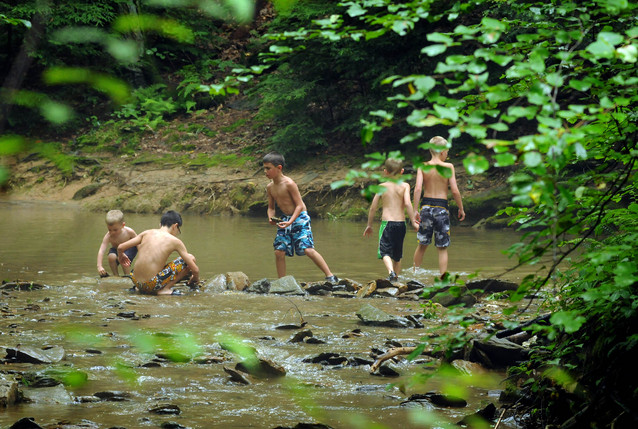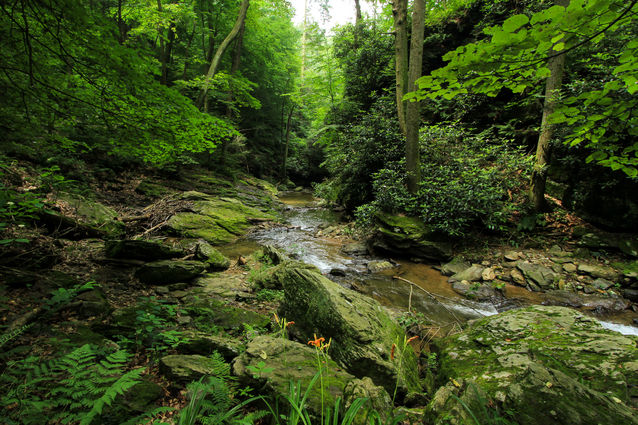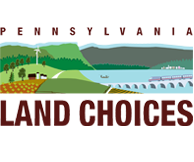Tucquan Glen
Location: Lancaster County
Organization: Lancaster County Conservancy
Like Lancaster County’s quilts, the Tucquan Glen Nature Preserve is a work of art comprised of many pieces. The Lancaster County Conservancy protected a square of land here and another there—slowly and persistently stitching together 12 parcels into the popular 338-acre preserve, plus two conservation easement agreements that increase the total protected habitat area to nearly 500 acres.
“The Glen has waterfalls and deep forest,” said Dr. Paul Ripple, a past board member of the conservancy. “Although it’s not far from the city, it feels like you’re in the middle of nowhere. It’s one of the most beautiful and mostly untouched lands in Lancaster County.”
A Special Place
Tucquan Glen can be stark and otherworldly. Prehistoric-size rhododendrons form a tunnel around a steep, rocky trail. Hemlocks tower over the rhododendrons — 80-foot monsters rooted only in the rocky fern and moss-draped slopes.
But on summer weekends, city residents flee the heat and head to Tucquan. People languish on the cool boulders above the Tucquan Creek and swim in the pools. It’s sometimes difficult to find parking in the three lots or on the roadside.
In the past, the Glen was a tourist destination, hosting private cabins. Later it was the site of a Boy Scout Camp. The 1883 book The History of Lancaster County describes its beauty:
“The rocks, crowned with magnificent growths of the mountain laurel, shut out the faintest glimmer of the sunlight, and one can almost imagine that he is surrounded by fairy enchantment.”
Protecting the Glen
For more than two decades the Conservancy has engaged in a low-key, yet persistent conservation effort in the Glen. The first acquisition took place in 1983, a 97-acre plot.
“We had pieces donated and others sold at bargain sale,” said Frank Wint, one of the Conservancy volunteers involved in early land acquisitions. “We’d get a map of who’s who in Tucquan Glen, knock on doors, and get the job done.
“There were some people who were truly sacrificial with the amount of money they gave up in light of their finances,” Frank recalled. “When we told one farmer who donated his land that his contribution may be tax deductible he said, ‘I don’t make enough money to pay taxes.'”
“That’s not to say we didn’t run across people who wanted to get every buck they could,” he added.
Land purchases were funded through grants from Lancaster County, the Pennsylvania Department of Conservation and Natural Resources’ Keystone Recreation, Park and Conservation Fund**, private foundations and individual donors.
When approached by the Conservancy, some landowners responded: “I’m too busy, give me the money and I’ll sell.” But more often than not, landowners wanted to be sure their land would be protected.
John Symonds, former executive director of the Conservancy, remembers how employees of Pennsylvania Power and Light Corporation, from top management on down, loved the Glen. In 1996, the corporation agreed to sell 97 acres to the Conservancy.
“There were many people in the company who were truly thinking of the community good,” he said. “That was a great acquisition. All involved in the decision and subsequent negotiations had a love for the area — more a love for the area than a love for the Conservancy. We had to earn that.”
Tucquan landowner Rod Harnish explains why he donated two parcels and a conservation easement to the Conservancy:
“In Lancaster County, there has been so much effort to protect farmland that the development is going into the forestland. LCC is in the business of preserving timberlands — it’s just as important. I’m selling timber off of my land right now. That’s something you can do every 25 years. You can’t do that if you built houses on it.”
Protection efforts in the Glen are ongoing.
“Any land in the Tucquan watershed is a target for conservation,” said Ralph Goodno, the Conservancy’s President. “It’s a high priority and always will be. We hope to continue our expansion of this preserve.”
Tucquan Glen: Classroom
The sixth graders become quiet.
They stop and listen to the gurgling and rushing of Tucquan Creek, sounds some are hearing for the first time.
Huge boulders vie for their attention, and the damp smell of deep forest permeates the air.
One day each spring, Tucquan becomes classroom for every sixth-grader in the Marticville School District. The lessons include history, biology, creative writing, geology, and physical education.
The day begins in the creek, scooping up macro invertebrates for study. Then it’s time for wildflower and tree identification.
Next, creative writing on Poet’s Rocks. Poetry is followed by an orienteering course. Then local history is taught on a hike to where Tucquan Creek flows into the Susquehanna River.
“It’s a lot of fun to do,” said Ron Walton, hike leader and teacher. “The kids have a great time when they’re down here.”
Ron is just one of the teachers taking advantage of the Conservancy’s program.
“We work with six school districts,” said Vic Brutout, Education Coordinator for the Conservancy, describing their program that gets students out of the classroom and in touch with the topics they are studying. The program also helps teachers meet Pennsylvania Department of Education requirements for science and ecology. There’s even a web-based education guide to the preserve.
Wonder is easily elicited in a place like Tucquan. Neither students nor teacher are immune to the magic.
“One of the neatest things I ever saw was a blue heron that took off gliding along the stream path, Ron said. “I’ve seen many herons before, but this was beautiful to see in the early evening with the water glistening in sunset and the bird following the twisting stream path. ”
It’s was just one of those unexpected treats you get from nature.”
What Land Gets Conserved?
“Our nature preserves typically started with the donation of a parcel. We’d then acquire land around that core to grow the preserve,” said Bob Behling, a public relations officer for the Conservancy. “We didn’t just get a huge hunk of land. It’s not that easy.”
Behling, who was a volunteer board member in the Conservancy’s early days, said there is a definite change in direction for the organization.
“We still take advantage of those opportunities, those generous land donations,” Behling said. “But now we identify priority areas that most warrant protection around the county. We focus our work there. We are much more strategic in our conservation.”
If these strategic priorities had been in place years ago, Tucquan would have been a high priority, Behling was pleased to note.
The Tucquan Glen Nature Preserve fits into a larger unfinished quilt of 21 nature preserves, part of the Conservancy’s vision for an interconnected system of natural areas, with a nature preserve in every township.









